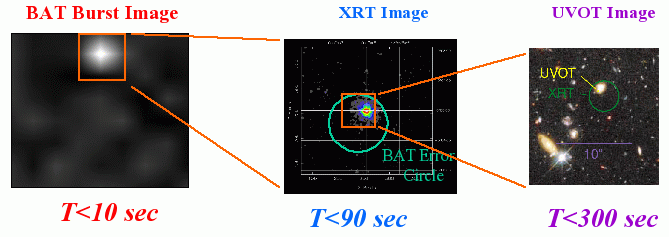- Home
- About
- Support
- Data Access
- Data Analysis
- Data Products
- Publications
-
Links
Databases NED Simbad GCN circulars archive GRB data table Software & Tools Swift Software (HEASoft) Xanadu WebPIMMS Institutional Swift Sites GSFC PSU OAB SSDC MSSL University of Leicester
The Neil Gehrels Swift Observatory

Swift, launched at 17:16 GMT on 20th November 2004, is a flexible, rapid-response satellite with a wide-field of view Gamma-Ray Burst detector and narrow field X-ray and optical telescopes. It is a NASA Medium Explorer mission, managed by the Goddard Space Flight Center and led by the Principal Investigator (formerly Neil Gehrels, now Brad Cenko); the satellite is operated by Penn State University.
Besides observing large numbers of GRBs (discovering about 90 a year), Swift spends a significant fraction of its time on Guest Investigator and Target of Opportunity observations.
Swift was built in order to:
- determine the origin of Gamma-Ray Bursts
- classify Gamma-Ray Bursts and search for new types
- determine how the blast-wave evolves and interacts with the surroundings
- use Gamma-Ray Bursts to study the early Universe
- perform the first sensitive hard X-ray survey of the sky
Further details about Swift can be found in Gehrels et al. (2004).
Swift GRB Response

As described in the Instruments on-board Swift section, the Burst Alert Telescope is the instrument which detects elevated gamma-ray emission. The BAT has a large field of view, allowing it to detect such gamma-rays from a large portion of the sky at any one time.
After this initial detection, Swift slews rapidly and autonomously, re-pointing itself to bring the detected burst into the field of view of the sensitive narrow field instruments (XRT and UVOT), which then observe the afterglow. Swift will provide spectra and multi-wavelength light-curves for the duration of the afterglow and, where possible, distance determinations. This will enable the most comprehensive study of GRBs and their host galaxies to date.
Naming Convention
New sources discovered by Swift will be designated SWIFT JHHMM.m +/- DDMM or SWIFT JHHMMSS.s +/- DDMMSS
There are three fundamental observation timescales for Swift. These are described in more detail on this page, where information on the target ID convention is also given.
